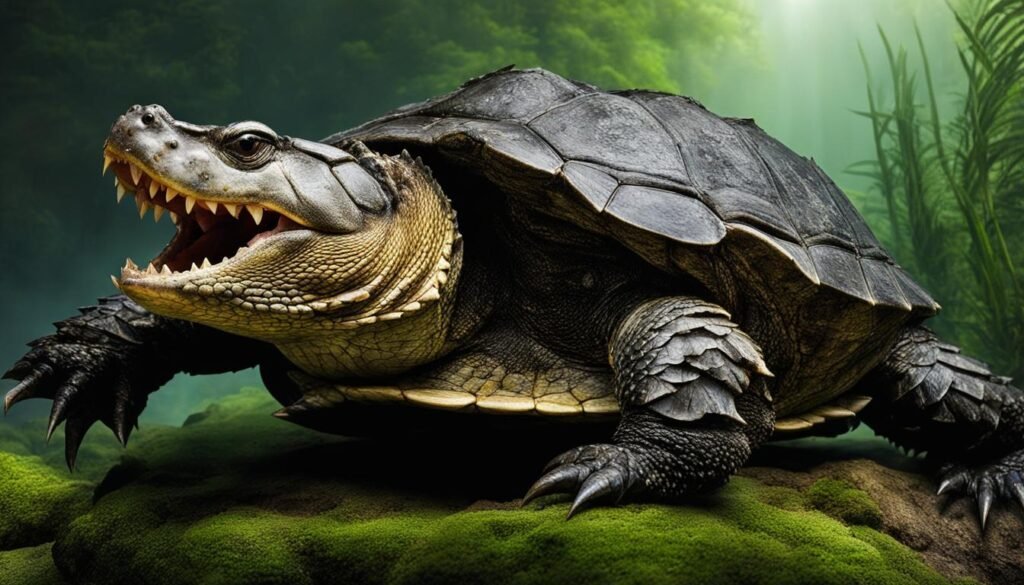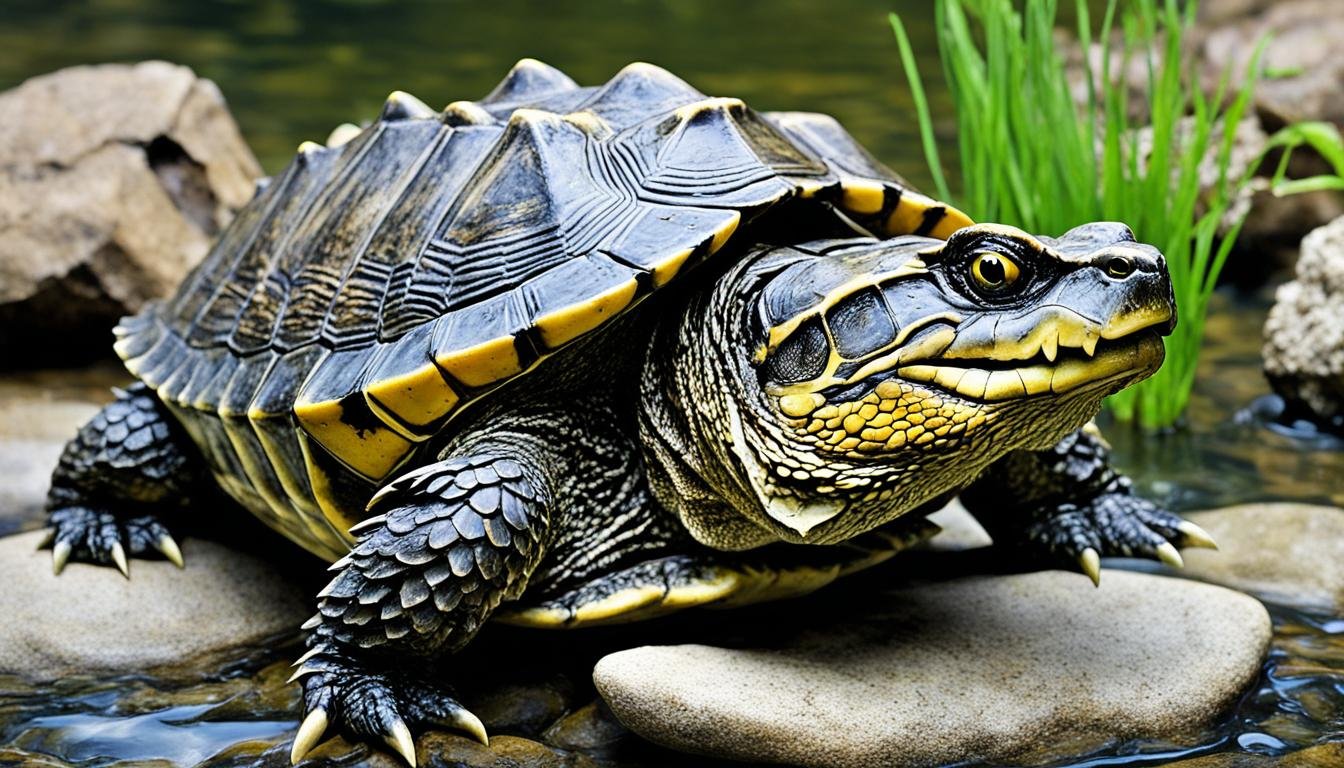Did you know that the Alligator Snapping Turtle is the largest freshwater turtle in North America? This incredible reptile is not only impressive in size but is also facing the threat of extinction, making it a critically important species to protect. As an endangered species, the Alligator Snapping Turtle plays a vital role in the ecosystem and requires urgent conservation efforts to ensure its survival.
Key Takeaways:
- The Alligator Snapping Turtle is the largest freshwater turtle in North America.
- It is an endangered species, requiring significant conservation efforts.
- Conservation efforts focus on protecting the turtle’s habitat and raising awareness.
- The turtle faces threats from habitat destruction and uncontrolled harvesting.
- Understanding the turtle’s behavior and adaptations is crucial for its conservation.
Appearance and Behavior of the Alligator Snapping Turtle.
The Alligator Snapping Turtle is an impressive reptile known for its distinctive appearance and fascinating behavior. As the largest freshwater turtle in North America, it showcases notable characteristics that set it apart from other species.
Distinctive Appearance
The Alligator Snapping Turtle exhibits a commanding presence with its large size and rough shell. Its shell features three vertical ridges, reminiscent of the ancient dinosaurs that once roamed the Earth. This unique dorsal pattern adds to its allure and visual appeal.
Apex Predator and Carnivorous Diet
The Alligator Snapping Turtle holds a prominent place in the food chain as an apex predator. With a powerful bite force, it can overpower its prey effortlessly. This impressive trait allows it to maintain its position as a top predator in its ecosystem.
The diet of the Alligator Snapping Turtle consists primarily of small creatures found in its habitat. Fish, musk turtles, and even acorns are among its favorite menu items. This carnivorous turtle has a diverse diet, consuming a variety of animals that contribute to its nutrition and survival.
Ambush Predator with Lure-like Tongue
The Alligator Snapping Turtle is an adept ambush predator. It lies in wait, camouflaged among aquatic vegetation, rocks, or logs, ready to strike at unsuspecting prey. What makes this turtle even more fascinating is its ability to lure prey using its tongue.
The turtle’s tongue acts as a worm-like appendage that it wiggles, attracting curious fish or other potential prey. Once the prey is enticed, it approaches, unaware of the hidden danger lurking beneath the water’s surface. This clever strategy enables the Alligator Snapping Turtle to secure its next meal with precision.
| Alligator Snapping Turtle | Diet |
|---|---|
| Largest Freshwater Turtle | Carnivorous |
| Apex Predator | Feeds on fish, musk turtles, and other animals |
| Ambush Predator | Lures prey with its tongue |
Habitat and Distribution of the Alligator Snapping Turtle.
The Alligator Snapping Turtle, an extraordinary aquatic turtle, is primarily found in freshwater habitats, including rivers, lakes, and swamps. These diverse ecosystems provide ample food sources and suitable conditions for the turtle’s survival. With a range extending from the southern states of Florida to Texas and as far north as Illinois, the Alligator Snapping Turtle has established itself as a prominent resident of the Southeast USA.
This species is most commonly encountered in the Gulf of Mexico region, where it thrives amidst the abundant waterways and wetlands. The Alligator Snapping Turtle has adapted to various aquatic environments, displaying remarkable flexibility in its habitat preferences. While it predominantly inhabits rivers, lakes, and swamps, it is also known to venture into brackish water systems on occasion.
A significant part of the Alligator Snapping Turtle’s natural range falls within the southeastern United States. This region, characterized by its rich biodiversity and interconnected ecosystems, provides an ideal environment for the turtle’s survival. The Alligator Snapping Turtle plays an important role in maintaining the ecological balance in these delicate habitats.
| Habitat | Distribution |
|---|---|
| Rivers | Gulf of Mexico region, Southeast USA |
| Lakes | Gulf of Mexico region, Southeast USA |
| Swamps | Gulf of Mexico region, Southeast USA |
The Alligator Snapping Turtle’s preference for habitats with tree and shrub cover highlights its need for adequate hiding places and suitable basking areas. These habitats provide the turtle with both protection and easy access to its prey. The lush vegetation surrounding the rivers, lakes, and swamps forms an intricate network, fostering a healthy and diverse ecosystem.
The Alligator Snapping Turtle’s distribution within its natural range reflects its unique tolerance for specific environmental conditions. Understanding its habitat requirements is crucial for conservation efforts aimed at preserving these stunning creatures and the delicate ecosystems they inhabit.
Threats to the Alligator Snapping Turtle.
The Alligator Snapping Turtle, like many other species, faces several threats that jeopardize its survival in the wild.
Habitat Loss
Habitat loss is a significant threat to the Alligator Snapping Turtle. The conversion of land for agriculture and urban development results in the destruction and fragmentation of the turtle’s natural habitats, such as rivers, lakes, and swamps. The loss of these vital ecosystems reduces the available resources and suitable nesting sites for the turtles, impacting their population size and distribution.
Overharvesting
Another major threat the Alligator Snapping Turtle faces is overharvesting. Historically, this species has been targeted for its meat and shells, leading to population declines. Uncontrolled harvesting can disrupt the natural balance of the turtle’s population and hinder its ability to recover.
Pollution
Pollution from industrial activities, agricultural runoff, and other sources poses serious risks to the Alligator Snapping Turtle. Contaminants, such as pesticides, heavy metals, and plastics, can accumulate in the turtle’s habitat, affecting water quality and the health of both the turtles and their prey. These pollutants can cause reproductive issues, weakened immune systems, and other detrimental effects.
Invasive Species
The introduction of invasive species is also a prominent threat to the Alligator Snapping Turtle. Invasive predators, such as feral pigs and fire ants, can prey upon the turtles or their eggs, disrupting their natural reproduction and survival. Invasive plants can alter the habitat structure and impact the availability of food and suitable nesting sites for the turtles.
Bycatch
Accidental capture in fishing gear, known as bycatch, is an additional threat to the Alligator Snapping Turtle. These turtles can become entangled in fishing nets or caught on hooks intended for other species, resulting in injuries or death. Bycatch can significantly impact the turtle’s population, particularly in areas where fishing activities are prevalent.
Overall, the Alligator Snapping Turtle faces a combination of threats from habitat loss, overharvesting, pollution, invasive species, and bycatch. Protecting and conserving these turtles require comprehensive efforts to address and mitigate these challenges, ensuring the long-term survival of this unique and vital species.
Conservation and Management of the Alligator Snapping Turtle.

Conservation efforts play a crucial role in protecting the Alligator Snapping Turtle, a species of special concern. In Florida, the turtle is safeguarded under the Endangered and Threatened Species Rule. Additionally, the US Fish and Wildlife Service is currently evaluating its eligibility for federal listing. Various states have implemented protections to preserve the turtle, including laws prohibiting its capture and sale.
To ensure the survival of the Alligator Snapping Turtle, conservation initiatives focus on multiple strategies:
Habitat Protection:
The preservation of the turtle’s habitat is a top priority. It involves creating and maintaining protected areas such as wetlands, rivers, and lakes where the Alligator Snapping Turtle thrives. These efforts contribute not only to the species’ well-being but also to the overall health of the ecosystem.
Regulations on Harvesting:
Regulating and limiting the harvesting of the Alligator Snapping Turtle is vital for its conservation. Establishing guidelines and implementing laws against excessive exploitation help maintain sustainable population levels.
Awareness and Education:
Raising awareness about the importance of the Alligator Snapping Turtle and its conservation status fosters public support and engagement. Educating communities, stakeholders, and policymakers about the ecological significance of the turtle encourages the implementation of effective conservation measures.
By prioritizing habitat protection, regulating harvesting, and promoting awareness, we can contribute to the successful conservation and management of the Alligator Snapping Turtle.
| Conservation Strategies | Description |
|---|---|
| Habitat Protection | Preserving and maintaining wetlands, rivers, and lakes that serve as the turtle’s habitat. |
| Regulations on Harvesting | Implementing guidelines and laws to limit the excessive harvesting of the Alligator Snapping Turtle. |
| Awareness and Education | Raising awareness about the importance of the turtle and educating communities, stakeholders, and policymakers about its conservation status. |
Reproduction and Life Cycle of the Alligator Snapping Turtle.
The Alligator Snapping Turtle, a remarkable species, follows a unique reproductive cycle. Let’s explore the nesting, incubation, sexual maturity, and overall life cycle of these magnificent creatures.
Courtship and Nesting
From February to April, Alligator Snapping Turtles engage in courtship rituals, where males attract females through various displays of behavior. After courtship, nesting takes place between late April and mid-May. Female turtles select suitable sites to lay their eggs, usually near freshwater bodies, and construct nests to protect them from predators.
Incubation
Females lay an average of 17-52 eggs per clutch in the nests they have carefully crafted. The incubation period lasts for approximately 100-110 days, during which the eggs are exposed to the surrounding temperatures. Interestingly, the sex of the hatchlings is determined by these temperature conditions. Cooler temperatures tend to produce male hatchlings, whereas warmer temperatures contribute to the arrival of females.
Sexual Maturity
Alligator Snapping Turtles experience a relatively long period before reaching sexual maturity. It usually takes them 11-13 years to develop fully. Upon reaching this milestone, they are capable of engaging in reproductive activities and continuing the cycle of life.
This intricate reproductive cycle of the Alligator Snapping Turtle ensures the survival and continuation of their species. By understanding their nesting, incubation, and sexual maturity, we can gain deeper insights into the remarkable life cycle of these extraordinary creatures.
Alligator Snapping Turtle Adaptations.

The Alligator Snapping Turtle has evolved a range of adaptations that contribute to its survival and success in its natural habitat. These adaptations allow the turtle to effectively capture prey, blend into its environment, determine the sex of its offspring, and detect potential food sources.
Bite Force
One of the most notable adaptations of the Alligator Snapping Turtle is its powerful bite force. With an incredibly strong jaw, this turtle is capable of capturing and immobilizing its prey with ease. Its sharp and robust beak-like mouth allows it to exert immense pressure, making it a formidable predator in its ecosystem.
Ambush Predator
The Alligator Snapping Turtle exhibits exceptional camouflage and remains motionless for extended periods, making it an efficient ambush predator. Its rough shell, covered in algae and debris, blends seamlessly with the surrounding environment, making it difficult for potential prey to spot. This stealthy approach enables the turtle to patiently wait for the perfect opportunity to strike.
Temperature-Dependent Sex Determination
Unlike many other species, the sex of Alligator Snapping Turtle hatchlings is determined by the temperature at which the eggs are incubated. Higher temperatures during incubation result in more females, while lower temperatures yield more males. This fascinating adaptation ensures a balanced population ratio and allows the species to adapt to changing environmental conditions.
Chemosensory Organs
The Alligator Snapping Turtle possesses specialized chemosensory organs located in its neck that enable it to detect prey underwater. These organs are equipped with receptors that respond to the chemical cues released by potential food sources. This sensory adaptation enhances the turtle’s ability to locate and capture its preferred prey, such as fish, ensuring its dietary requirements are fulfilled.
By combining its powerful bite force, ambush predator tactics, temperature-dependent sex determination, and chemosensory organs, the Alligator Snapping Turtle has evolved to be a highly efficient and successful predator in its aquatic environment. These adaptations have played a crucial role in the turtle’s survival and continued presence in freshwater ecosystems.
Interesting Facts about the Alligator Snapping Turtle.
The Alligator Snapping Turtle, with its unique characteristics and behavior, is a captivating species. Let’s explore some intriguing facts about this fascinating turtle:
- Dorsal Ridges: The Alligator Snapping Turtle’s rough shell is adorned with three distinct dorsal ridges, reminiscent of a dinosaur’s back. These ridges give the turtle a striking appearance and contribute to its overall strength and protection.
- Lure-like Tongue: With a tongue that resembles a lure, the Alligator Snapping Turtle is a master of deception. It uses its tongue to attract unsuspecting prey, mimicking the movement of a worm or small fish. Once within range, the turtle swiftly captures its meal.
- Slow Breathing: The Alligator Snapping Turtle has a slow breathing rate, which necessitates frequent intake of air. This unique adaptation allows the turtle to conserve energy while maintaining its metabolism, even in challenging aquatic environments.
- Aggressive Behavior: While typically docile and non-threatening, the Alligator Snapping Turtle can display aggressive behavior when provoked or threatened. With its powerful bite and defensive instincts, it can effectively protect itself from potential dangers.
These fascinating facts highlight the incredible adaptations and behaviors that make the Alligator Snapping Turtle a truly remarkable species.
Dorsal Ridges
The Alligator Snapping Turtle’s rough shell features three distinct dorsal ridges, giving it a dinosaur-like appearance.
Lure-like Tongue
The Alligator Snapping Turtle has a tongue that resembles a lure, allowing it to attract prey effectively.
Slow Breathing
The Alligator Snapping Turtle has a slow breathing rate and requires frequent inhalation of air to sustain itself.
Aggressive Behavior
Although generally peaceful, the Alligator Snapping Turtle can exhibit aggressive behavior when provoked, using its powerful bite for defense.
Invasive Species and Human Interactions with the Alligator Snapping Turtle.
Invasive populations of the Alligator Snapping Turtle have been reported in South Africa and certain parts of Europe. These populations pose a potential threat to local wildlife and ecosystems. It is crucial to handle the turtle with caution due to its powerful bite, which can cause harm to humans.
Although there have been no verified cases of fatal attacks on humans, it is advisable to avoid direct contact with the Alligator Snapping Turtle. This species should be observed from a safe distance to ensure both human safety and the well-being of the turtle.
When encountering the Alligator Snapping Turtle, it is important to respect its natural behavior and habitat. Do not attempt to touch or provoke the turtle, as it may feel threatened and respond aggressively. If you come across an injured or stranded turtle, contact local wildlife authorities or organizations for assistance.
Impact on Local Wildlife
The presence of invasive populations of the Alligator Snapping Turtle can negatively impact local wildlife. As an apex predator, these turtles can disrupt the balance of ecosystems by preying on native species and competing for resources. This can lead to a decline in populations of other aquatic organisms and alter the structure and functioning of the ecosystem.
Handling Precautions
When handling the Alligator Snapping Turtle, it is essential to take precautions to ensure the safety of both humans and the turtle. Here are some guidelines to follow:
- Always wear protective gloves and handle the turtle by its shell to minimize the risk of bites.
- Do not attempt to pick up or restrain the turtle without proper training or authorization.
- Avoid sudden movements or loud noises that may startle the turtle and trigger defensive behavior.
- If you encounter an injured or distressed Alligator Snapping Turtle, contact local wildlife authorities or a licensed wildlife rehabilitator for assistance.
By taking these handling precautions and promoting awareness about the potential impact of invasive populations, we can coexist with the Alligator Snapping Turtle while preserving the integrity of local ecosystems.
Conclusion
The Alligator Snapping Turtle is an extraordinary species that plays a vital role as an apex predator in its ecosystem. Despite being listed as a vulnerable species and facing numerous threats, efforts are underway to conserve and protect this remarkable turtle. Conservation initiatives focus on safeguarding its habitat and raising awareness about its conservation status.
Understanding the reproduction, adaptations, and behavior of the Alligator Snapping Turtle is crucial for ensuring its long-term survival. By studying its reproductive cycle and the temperature-dependent sex determination of hatchlings, scientists can gain valuable insights into the species and implement effective conservation strategies. Additionally, the turtle’s adaptations, such as its powerful bite force and chemosensory organs, contribute to its success as a predator.
It is essential for human interactions with the Alligator Snapping Turtle to prioritize caution and respect for the turtle’s natural behavior and habitat. While it is a resilient species, the turtle faces threats from habitat loss, overharvesting, pollution, and invasive species. By minimizing human impact, promoting responsible behavior, and supporting conservation efforts, we can contribute to the preservation of this remarkable species for future generations.
In conclusion, the Alligator Snapping Turtle is an awe-inspiring reptile that requires our attention and protection. Its conservation is crucial to maintain the balance of the ecosystem. By valuing its role as an apex predator, understanding its reproduction and adaptations, and respecting its habitat, we can ensure a brighter future for the Alligator Snapping Turtle and the biodiversity it represents.
FAQ
What is the Alligator Snapping Turtle?
What is the habitat and diet of the Alligator Snapping Turtle?
What are the threats to the Alligator Snapping Turtle?
What are the conservation efforts for the Alligator Snapping Turtle?
How does the Alligator Snapping Turtle reproduce?
What are the adaptations of the Alligator Snapping Turtle?
What are some interesting facts about the Alligator Snapping Turtle?
Are there invasive populations of the Alligator Snapping Turtle?
How should humans interact with the Alligator Snapping Turtle?
References
| Organization Name | URL |
|---|---|
| International Reptile Conservation Foundation (IRCF) | https://www.ircf.org/ |
| Herpetological Conservation International | https://herpconservation.com/index.html |
| Society for the Study of Amphibians and Reptiles (SSAR) | https://ssarherps.org/conservation/conservation-resources/ |


1 thought on “Alligator Snapping Turtle Facts & Conservation”